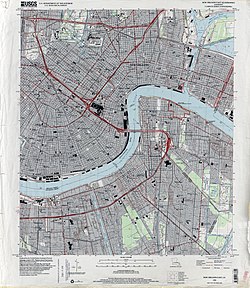Lafayette Cemetery No. 1 is a historic cemetery in the Garden District neighborhood of New Orleans, Louisiana. Founded in 1833 and still in use today, the cemetery takes its name from its location in what was once the City of Lafayette, a suburb of New Orleans that was annexed by the larger metropolis in 1852.[1][2] The city's first planned cemetery,[3] it is notable for the architectural significance of its tombs and mausoleums, often containing multiple family members, and for its layout, a cruciform plan that allowed for funeral processions.[4]
Lafayette Cemetery No. 1 | |
 Entrance gate to the cemetery. | |
| Coordinates | 29°55′43″N 90°05′07″W / 29.928701°N 90.085361°W |
|---|---|
| Built | 1833 |
| Architect | Benjamin Buisson |
| Architectural style | Neo-Classical |
| NRHP reference No. | 72000559 |
| Added to NRHP | 1972 |
Confined within a single city block, the cemetery contains approximately 1,100 family tombs and 7,000 people.[5]
Conservation
editThe Cemetery was included in the National Register of Historic Places on February 1, 1972, for its architectural and social-historical importance.[6]
The World Monuments Fund placed Lafayette Cemetery No. 1 on its "Watch" list in 1996 due to the dilapidated state of some tombs, and it did so again in 2006 after Hurricane Katrina damaged much of the cemetery. The Fund subsequently partnered with Save Our Cemeteries, a nonprofit focused on preserving Louisiana's historic cemeteries, and the Preservation Trades Network to repair tombs and restore the cemetery's landscape.[7] Save Our Cemeteries continues to advocate for the cemeteries and make repairs.[8] The City of New Orleans closed the cemetery in September of 2019 to visitors. There is no date available for when it will reopen.
Notable tombs
edit- John Howard Ferguson, defendant in the 1896 Plessy v. Ferguson court case that upheld the constitutionality of racial segregation laws for public facilities.
- Harry T. Hays, an American Army officer serving in the Mexican–American War and a general who served in the Confederate Army during the American Civil War; leader of a brigade known as the "Louisiana Tigers."
In popular culture
editLiterature
editWhile promoting her 1995 novel Memnoch the Devil, writer Anne Rice emerged from a coffin after riding through the cemetery. At the time, she lived in the nearby Garden District.[citation needed]
Films and TV series
editFilms and TV series shot in the cemetery include:[9][better source needed]
- Hard Target (1993)
- Interview with the Vampire (1994)
- Double Jeopardy (1999)
- Dracula 2000 (2000)
- Deja Vu (2006)
- The Vampire Diaries (2009–2017)
- Jonah Hex (2010)
- The Originals (2013–2018)
- Black and Blue (2019)
Other
editMusic videos by the following artists have been shot in the cemetery:[citation needed]
See also
editReferences
edit- ^ "Save Our Cemeteries : Cemeteries of New Orleans : Cemeteries : Lafayette No. 1". www.saveourcemeteries.org. Retrieved November 14, 2018.
- ^ "The turbulent history behind the seven New Orleans municipal districts". NOLA.com. Retrieved November 14, 2018.
- ^ "Lafayette Cemetery No. 1". World Monuments Fund. Retrieved November 14, 2018.
- ^ "Save Our Cemeteries : Cemeteries of New Orleans : Cemeteries : Lafayette No. 1". www.saveourcemeteries.org. Retrieved November 14, 2018.
- ^ "Save Our Cemeteries : Cemeteries of New Orleans : Cemeteries : Lafayette No. 1". www.saveourcemeteries.org. Retrieved November 14, 2018.
- ^ "National Register Digital Assets". National Park Service. February 1, 1972.
- ^ "Lafayette Cemetery No. 1". World Monuments Fund. Retrieved November 14, 2018.
- ^ "Nonprofit Save Our Cemeteries repairs tombs at Lafayette Cemetery No. 2". NOLA.com. Retrieved November 14, 2018.
- ^ "IMDb: Titles with Location Matching "lafayette cemetery" (Sorted by Match Descending)". IMDb. Retrieved November 14, 2018.
External links
edit- Media related to Lafayette Cemetery 1, New Orleans at Wikimedia Commons
- Lafayette Cemetery No. 1 at Find a Grave


